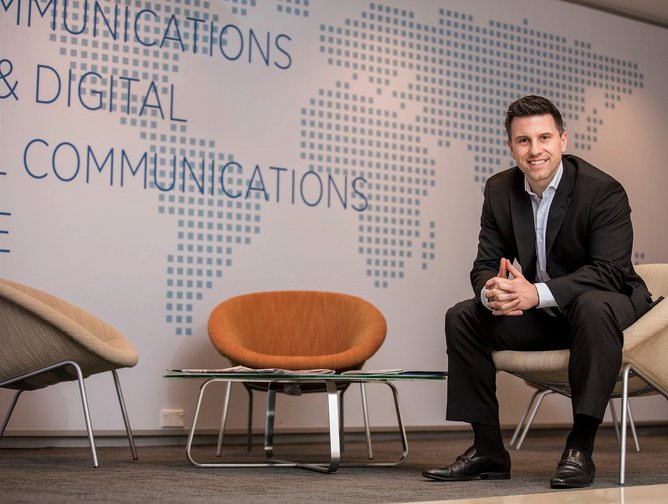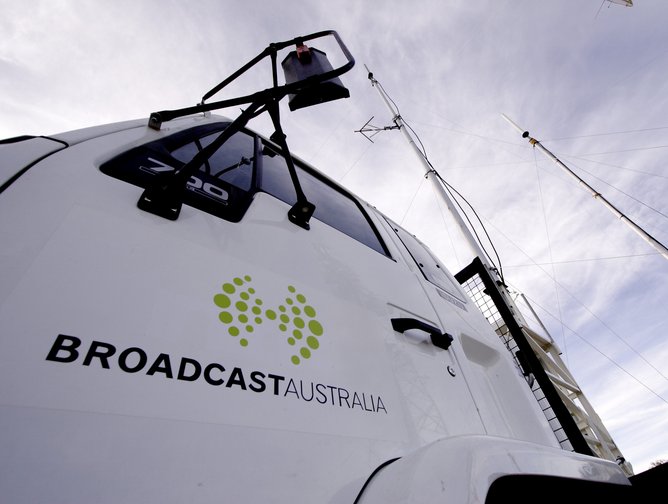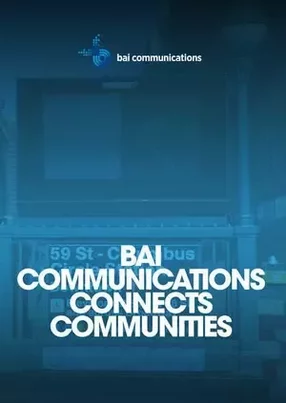People of all generations now accept that their mobile phone is the technology hub that enables every aspect of life. Work, entertainment, social interaction, information, shopping, finances, learning: the device in our pocket gives us access to all of it – just so long as we can connect.
Mobile devices are now used predominantly for data. So, exceptional cellular coverage and Wi-Fi is very important. People expect this data connectivity, whether for texting, browsing or streaming. Having the signal drop, or no signal at all, on a train is a frustration that BAI Communications is making a thing of the past.
BAI Communications operates in Australia (Broadcast Australia), Hong Kong, Canada, the UK and in New York with majority-owned BAI Communications company Transit Wireless. The company designs, builds and operates communications infrastructure – cellular, Wi-Fi, broadcast, radio and IP networks. In Australia through Broadcast Australia, it owns and operates one of the most extensive transmission networks in the world, delivering 59 million broadcasting hours to 99% of the population. In times of crisis, national broadcasters rely on them to maintain the connection with Australians – flood, fire, cyclone or other natural disaster – and emergency services rely on BAI to help keep them informed.
In New York and Toronto, BAI enables more than 7 million* daily subway commuters to shop, share, stream, earn and learn through its cellular and Wi-Fi networks and in Hong Kong, commuters on the MTR collaborate, create and stay connected thanks to their trusted expertise in designing and delivering high-quality networks in confined and complex transport systems. In the UK, with its global network of experts paired with local in-depth knowledge, it is working with industry leaders to explore the role of technology in the transport system of the future.
Peter Turnbull joined BAI in 2015 as its CIO. He brought with him many years’ experience in the banking and financial services sector, but as he says: “Core technology is ubiquitous, you really challenge yourself to understand how the business capabilities interact and learn the language of the domain.” While broadcasting is a key service of BAI in Australia through the Broadcast Australia business, the company had already started its expansion into transit communications in other markets.
“The brief I was given was as unique as it was challenging - establish a technology platform to modernise the core IT capabilities of a mature business (Broadcast Australia), enable the wider BAI Communications Group to enter into new regions and build a foundation to connect our established international subsidiaries.” These three goals presented a challenge he found irresistible.
Though the technology infrastructure was largely on-premise and imperfectly connected across the group, he quickly realised his biggest challenge was cultural. Like many traditional IT organisations, IT operated as a service provider with a contract to ‘the business’. Switching this mindset and moving the conversation from ‘IT and the business’ to ‘IT is part of the business’ that continues to enable but also contributes to the business strategy, has been fundamental.
This mindset shift is a two-way street, “as technologists we need to accept that IT no longer controls all things technology, this takes some getting used to; the convergence of operational technology (OT) and IT along with ‘Edge IT’ (his preferred name over shadow IT) has meant we are now a key partner helping to build new capabilities. We are domain experts in enterprise technology, our role is to establish a solid foundation and ensure the enterprise plumbing works and then partner, guide and enable our peers and their people on their own technology journey.”
Pillars of transformation
The digital transformation started in 2016. In describing the transformation for BAI it is helpful to look at the four pillars on which it depends. The first of these was to provide a firm foundation and transform the infrastructure that Turnbull calls ‘enterprise plumbing’. “We will never be fast enough to take the business forward unless we have a solid and adaptable set of infrastructure capabilities and services to work with.”
The original infrastructure he found was a traditional, on-premise infrastructure, that was out of support, challenging to manage and “not capable of meeting our requirements to modernise the Broadcast Australia business let alone connect our international ones”.
“We needed an infrastructure capable of bringing together IaaS, PaaS, SaaS and on-premise solutions. We needed a fast network at each regional office, as the existing links would not support our cloud-first aspirations. We needed a set of core technology services including identity management, to run and support this infrastructure and most importantly, we need an infrastructure that could support future convergence of OT and IT.”
After careful consideration Turnbull decided a Microsoft stack was optimal in his quest to move the infrastructure to a service model, located in the Cloud. “We have built a virtual data centre capability in Azure and challenged ourselves to have 80% of our workload running in the cloud by 2020. We moved our provisioning process to Azure Resource Manager (enabling infrastructure-as-code) and rebuilt our identity and access management capability using Azure Active Directory (AAD). This was a game changer because it provided a way to bring together our subsidiaries, manage access to cloud services with single sign-on and quickly deploy user and device services like multi factor authentication (MFA) and conditional access which have traditionally been complex or expensive to deploy and maintain.”
A new work environment
The second pillar, which ran in parallel with the infrastructure overhaul, was building a modern workplace, which wasn’t just a hardware and Windows refresh, but a full rethink on how to securely access, surface and share information across subsidiaries, how to enable ‘boundless collaboration’ no matter what time-zone people were in or device they were using and how to provide a consistent and integrated experience for everybody. To achieve this, Turnbull deployed Office 365, starting with Yammer.He progressively introduced core services including Exchange Online, Skype for Business, OneDrive and Microsoft Teams across Australia and the UK with plans to integrate the other international subsidiaries over the next 12 months.
“Yammer was the first Office 365 service we deployed in Australia,” he says. “It is a great tool for building open, cross-functional communities which have become key in transforming the way we share information.” As an example, operational questions or issues with operational equipment are being shared over Yammer, drawing in responses from engineers across Australia who may have encountered the same problem or had previous experience with the equipment.
There are other game changers in the stack. “Skype for Business has replaced over 15 PBX solutions and introduced new ways to communicate, some expected and some unexpected,” says Turnbull. “Not only was it a big cost saving; suddenly you could effortlessly connect our international businesses into a meeting with video, voice, screen sharing and instant messaging. I can walk into a meeting room and click one button to join a meeting instead of having to find a dial-in number, type in the conference code and remember a PIN. Best of all when we move into new countries we don’t have to set up PBX infrastructure, we just provision phone numbers and conferencing services through a single portal.”
They have deployed several Surface Hub devices, which have really changed the way meetings are conducted, he adds. “With integrated Skype, a digital whiteboard and wireless projection to the screen, I walk into a meeting and we don’t have to sit down anymore.
“We are standing up, collaborating on a digital whiteboard and effortlessly bringing people together (inside and outside the organisation), through technologies such as Skype/, Teams, document co-authoring and digital whiteboards accessible on any device”. It's a much more engaging experience (even remotely) when you're able to collaborate like this.”
Recognising that BYOD can be complicated, Turnbull introduced a CYOD (choose your own device) workstation approach running Windows 10. Faced with the need to replace older hardware, staff were given a range of workstation options. This combined elements of choice and interoperability. These new implementations and policies came of course with the challenge of change management. One of the most effective ways of helping people, he says, was to set up communities on Yammer – the most popular of these was the ‘modern workstation’ group where people could pose any questions they had. This group quickly evolved into a self-service platform for change management as, rather than having to wait for an answer from the service desk, their queries could be directed collaboratively to other sources and resources within the business. It’s a dynamic repository of knowledge accessible from any device (through the introduction of mobile device management) in any location.
He’s also really pleased with the introduction of the latest service for corporate video sharing, Microsoft Stream. Distributing information via a blog has been augmented by fortnightly videos and interviews with specialists in the IT team to explain current projects. “All this is accessible on their mobile devices, their workstation or their home PC. Now we are combining video distribution with blog posts and posts in Yammer. Communication needs to come through diverse channels, recognising that people consume information in different ways.”
The Office 365 suite has enabled our modern world at BAI: “Being cloud- based makes it much easier for us to enter new geographical markets.”
See also:
- How SCT Group leverages technology and a commitment to service to provide logistics solutions across
- Exclusive interview: Jabil’s VP of supply chain management, John Caltabiano
- How Brightstar is making mobile technology accessible with its latest digital disruption
Data and information management
The third pillar of transformation is focused on information management and Peter Turnbull is sponsoring this initiative across the Broadcast Australia and UK businesses. “Many of the challenges we (and other organisations) face stem from a data or an information issue, be it poor quality or unknown data or poor practices for governing, exchanging and consuming information.” This pillar, which is still a work in progress, “is the fabric that joins together our business capabilities as it provides a way to build a common language we all speak,” says Turnbull. “We have focused our strategy around the management, integration and availability of structured, unstructured and spatial data (location-based data for the design and run of our sites which includes drawings, maps and photos).”
One of the first solutions introduced was a data warehouse hosted in Azure. The solution, implemented by Altis, provided a way to integrate data from systems of record, as well as data from other internal and external API’s using the Azure Data Factory. “We now bring together large volumes of data, from multiple sources, and make them available to our teams to consume or use in their technology solutions and business processes. When we need additional internal or external data, we use established pipelines to quickly make this data available,” says Turnbull.
Altis also helped with the implementation of a new reporting and analytics platform using PowerBI. The combination of the new data warehouse and PowerBI provided a modern solution to report upon (and share with customers through the PowerBI portal) the performance of Digital Television (DTV) services at all Broadcast Australia tower sites. A culture of change
The fourth pillar which has been enabled by the first three, is the progressive transformation of business capabilities. Unlike the infrastructure and modern workplace transformation, the transformation of business capabilities is a true cross-functional collaboration. Over the last 3 years, Turnbull has managed the introduction of a group-wide human capital management system (HCM), a health, safety and environment (HSE) system and upgraded the existing asset management solution.
“The introduction of the HSE solution has provided an easier way to capture incidents or near misses which help us improve our HSE capability. Incidents and near misses can be reported straight away by jumping onto your mobile device and registering what has occurred.This provides quicker visibility allowing for fast actions and decisions to be made.” With the technology foundations now in place, Turnbull in collaboration with the leadership team, are building a roadmap to transform key business capabilities including service management, site access and portfolio and project management.
There’s always a fifth pillar to IT transformation, and that’s security. BAI, like many companies, use a defence-in-depth approach to security across its administrative, technical and physical environments. In the first half of 2018 the company achieved ISO27001 certification: “The certification provides the certificate, however the cultural change and shift in mindset we achieved by going through this process has provided a foundation for the other pillars we have introduced. We have MFA across all our user accounts; encryption and mobile device management on our workstations and devices, we have a SIEM and security solutions monitoring our environment, However, risk-awareness and personal accountability for security on the part of everyone in the business is as important as the barriers we build”.
In closing, Peter Turnbull reflects “As technologists we need to be able to accept that IT is no longer the only source of technical innovation in the business. We are finding that more and more people have IT skills and unique experiences with technology transformation when they come into the organisation. Our role is to enable them to use their skills and experiences in new and innovative ways to help drive our digital transformation.
*December 2017. Source: Toronto Transit Commission and Metropolitan Transit Authority





